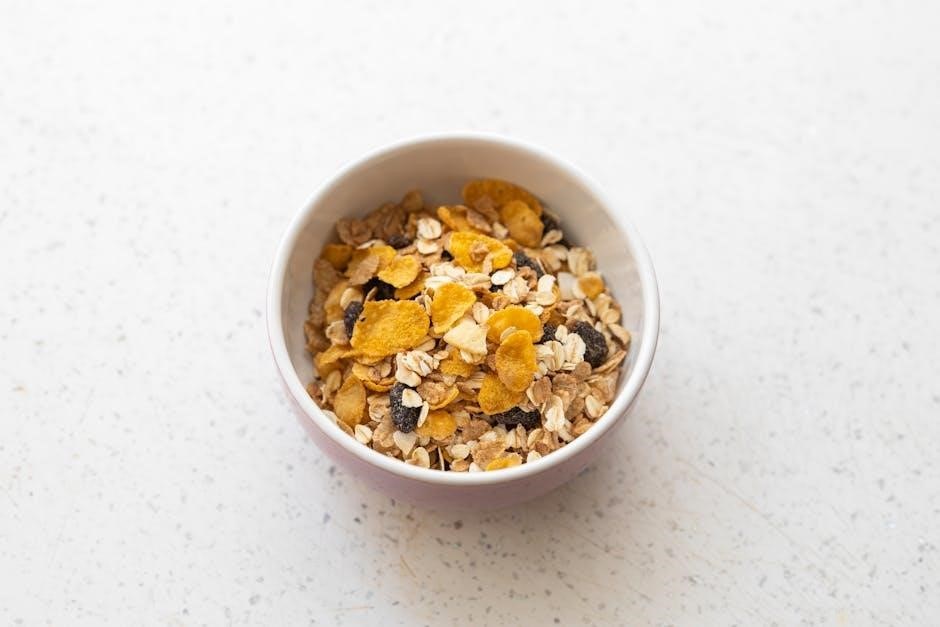This 30-day meal plan is designed to help alleviate IBS symptoms by eliminating high-FODMAP foods․ It offers structured recipes‚ portion guidance‚ and tips for a balanced‚ symptom-free diet․
Understanding FODMAPs and Their Impact on Digestive Health
FODMAPs are types of carbohydrates that can cause digestive discomfort in sensitive individuals․ They include fermentable oligosaccharides‚ disaccharides‚ monosaccharides‚ and polyols․ These carbs are poorly absorbed in the gut‚ leading to bloating‚ gas‚ and pain for people with IBS․ By identifying and managing high-FODMAP foods‚ individuals can reduce symptoms and improve digestive health․ The low-FODMAP diet is a proven strategy to alleviate IBS-related issues‚ focusing on eliminating trigger foods temporarily to reset the digestive system․ This approach helps identify personal food sensitivities‚ allowing for a more tailored diet long-term․ Understanding FODMAPs is the first step toward a symptom-free digestive life․
Benefits of a Low FODMAP Diet for IBS Symptom Relief
A low FODMAP diet is highly effective in reducing IBS symptoms such as bloating‚ gas‚ and abdominal pain․ By eliminating high-FODMAP foods‚ the digestive system is less irritated‚ leading to significant symptom relief․ Clinical studies show that approximately 75% of IBS patients experience improvement during the elimination phase․ This structured approach allows individuals to identify specific food triggers‚ enabling a personalized diet long-term․ The diet not only alleviates discomfort but also enhances overall quality of life by promoting regular digestion and reducing anxiety about food choices․ With a clear‚ evidence-based plan‚ the low FODMAP diet offers hope for managing IBS and transforming eating into a positive‚ symptom-free experience․

The Elimination Phase Explained
The elimination phase removes high-FODMAP foods for 2-6 weeks to reset the digestive system and identify trigger foods‚ providing a foundation for long-term symptom management․
What Foods to Avoid During the First 2-6 Weeks
During the elimination phase‚ high-FODMAP foods like onions‚ garlic‚ beans‚ wheat‚ and high-lactose dairy should be avoided to reduce digestive discomfort․ Specific fruits‚ such as apples and pears‚ and vegetables like broccoli and cauliflower‚ are also restricted due to their high FODMAP content․ Processed foods‚ sugary snacks‚ and certain grains like rye and barley should be excluded․ Portion control is crucial‚ as even seemingly low-FODMAP foods can trigger symptoms in large quantities․ This temporary restriction allows the digestive system to reset‚ helping identify personal triggers during the reintroduction phase․ Sticking to FODMAP-friendly alternatives ensures a smoother transition and better symptom management․
How to Identify High FODMAP Foods
Identifying high-FODMAP foods requires understanding the five FODMAP categories: oligosaccharides‚ disaccharides‚ monosaccharides‚ and polyols․ Common high-FODMAP foods include onions‚ garlic‚ beans‚ wheat‚ and high-lactose dairy․ Certain fruits like apples and pears‚ and vegetables like broccoli and cauliflower‚ are also high in FODMAPs․ Processed foods‚ sugary snacks‚ and grains like rye and barley should be avoided․ Portion size matters‚ as even low-FODMAP foods can become high-FODMAP in large amounts․ Referencing a FODMAP rating system or a reliable food list can help identify problematic foods․ Always check labels and opt for certified low-FODMAP products to ensure compliance with your diet plan;
Importance of Portion Control
Portion control is crucial on a low-FODMAP diet‚ as even naturally low-FODMAP foods can become high-FODMAP in large quantities․ For example‚ a small serving of blueberries is low-FODMAP‚ but eating too many can trigger symptoms․ Measuring tools like cups or scales help ensure accuracy․ Foods like lactose-free milk and gluten-free bread should be consumed in moderation․ Tracking portion sizes in a symptom journal can help identify tolerance levels․ Consistency is key to avoiding digestive discomfort and achieving the best results during the elimination phase․ Over time‚ this practice becomes second nature‚ making it easier to manage your diet long-term․

Creating Your 30-Day Meal Plan
A structured 30-day low-FODMAP meal plan provides clear guidelines for breakfast‚ lunch‚ dinner‚ and snacks‚ ensuring a balanced and symptom-free dietary approach to managing IBS effectively․
Breakdown of Weekly Meal Structures
This 30-day low-FODMAP meal plan is divided into four weekly structures‚ each providing balanced and nutritious meals․ Week 1 focuses on foundational low-FODMAP foods like gluten-free oats‚ lactose-free milk‚ and lean proteins․ Week 2 introduces more variety with recipes like grilled chicken salads and tuna bowls․ Week 3 incorporates new flavors with dishes such as turkey stir-fries and salmon bowls․ Week 4 emphasizes diversity with meals like tofu and vegetable stir-fries‚ ensuring a wide range of flavors and nutrients․ Each week includes breakfast‚ lunch‚ dinner‚ and snack options‚ with portion sizes carefully controlled to avoid triggering symptoms․ The plan progresses gradually‚ allowing your digestive system to adapt and heal while maintaining nutritional balance and flavor variety․ The goal is to reduce digestive discomfort and promote overall well-being through a structured and thoughtful approach to eating․
Sample Recipes for Breakfast‚ Lunch‚ and Dinner
Start your day with a delicious low-FODMAP breakfast like overnight oats made with lactose-free milk‚ topped with fresh berries and chia seeds․ For lunch‚ enjoy a grilled chicken salad with mixed greens‚ cucumber‚ and carrots‚ dressed with olive oil and lemon juice․ Dinner options include flavorful dishes like grilled salmon with gluten-free pasta and low-FODMAP tomato sauce‚ or a turkey stir-fry with rice noodles and sautéed vegetables․ These recipes are designed to be easy to prepare‚ nutritious‚ and free from high-FODMAP ingredients‚ ensuring you stay on track while enjoying satisfying meals․ Each recipe adheres to portion guidelines to help manage symptoms and promote digestive comfort․
Snack Ideas That Are FODMAP-Friendly
Keep your energy levels steady with tasty‚ low-FODMAP snacks․ Fresh fruit like bananas‚ berries‚ or citrus are excellent choices‚ as they are naturally low in FODMAPs․ For a savory option‚ try carrot or celery sticks paired with lactose-free cheese or almond butter․ Hard-boiled eggs‚ gluten-free crackers with lactose-free cheese spread‚ or a small handful of nuts like almonds or macadamias also make great snacks․ Hydration is key‚ so consider herbal teas or water with a splash of lemon․ Always check portion sizes to ensure snacks remain low in FODMAPs and avoid triggering symptoms․ These snacks are easy to prepare and perfect for on-the-go‚ helping you stay compliant with your low-FODMAP diet․

Grocery Shopping Guide
Stock your pantry with low-FODMAP essentials like gluten-free grains‚ lactose-free dairy‚ fresh fruits‚ and vegetables․ Choose certified gluten-free products and FODMAP-friendly brands to simplify your shopping experience․
Essential Low FODMAP Foods to Stock
Stock your pantry with low-FODMAP staples like gluten-free grains (rice‚ quinoa‚ gluten-free pasta)‚ lactose-free milk‚ and certified gluten-free bread․ Fresh fruits such as bananas‚ berries‚ and citrus are excellent choices‚ while vegetables like carrots‚ cucumbers‚ and spinach are FODMAP-friendly․ Proteins like chicken‚ turkey‚ and fish are naturally low in FODMAPs․ Incorporate healthy fats like olive oil and avocado․ Snacks such as almonds (in small portions) and lactose-free yogurt are great options․ Always check for certified gluten-free labels and portion sizes to ensure compliance with the low-FODMAP diet․ Refer to recommended brand lists for trusted products that align with your dietary needs․
Recommended Brands and Products

When following a low-FODMAP diet‚ choosing the right brands ensures compliance and convenience․ Opt for lactose-free milk like Almond Breeze or Lactaid․ For gluten-free options‚ consider Udi’s bread and Schar pasta․ FODMAPPED is a trusted brand offering certified low-FODMAP sauces and snacks․ For dairy alternatives‚ So Delicious and Coconut Dream are excellent choices․ Fresh vegetables and proteins like chicken and fish are naturally low in FODMAPs․ Snacks such as Green Valley lactose-free yogurt and FODMAPPED energy bars are great options․ Always check for certifications and portion sizes to maintain adherence to the diet․ These products simplify meal planning and grocery shopping while keeping your meals flavorful and balanced․

Cooking Tips for a Low FODMAP Diet
Use garlic-free seasonings‚ opt for gluten-free grains‚ and substitute high-FODMAP vegetables with low-FODMAP alternatives․ Meal prep in advance to save time and ensure compliance with the diet․
Substituting High FODMAP Ingredients
Substituting high FODMAP ingredients is essential for maintaining flavor while adhering to the diet․ Replace onions and garlic with garlic-infused oil or the green parts of scallions․ For wheat‚ opt for gluten-free alternatives like rice flour or quinoa․ Choose lactose-free dairy or non-dairy milk like almond or rice milk․ Swap high-FODMAP vegetables like cauliflower with zucchini or bell peppers․ When cooking‚ use herbs and spices for seasoning instead of high-FODMAP sauces․ Always check labels for certified gluten-free products․ These substitutions ensure meals remain delicious and compliant with the low FODMAP diet‚ helping to manage symptoms effectively․ Portion control is also key to avoiding accidental high FODMAP intake․
Simple Meal Prep Strategies
Meal prep is a cornerstone of the low FODMAP diet‚ ensuring consistency and reducing stress; Start by planning your meals for the week‚ focusing on balanced and varied options․ Prep proteins like grilled chicken or fish in advance‚ and portion them for easy use in salads or stir-fries․ Chop low FODMAP vegetables like zucchini‚ carrots‚ and bell peppers‚ and store them in airtight containers․ Cook gluten-free grains like quinoa or rice in bulk and use throughout the week․ Keep a stash of pre-made snacks‚ such as hard-boiled eggs or lactose-free yogurt‚ for quick grabs․ Label and date all prepped items to maintain organization․ Simple‚ batch cooking strategies like these save time and help maintain adherence to the diet‚ making it easier to stay on track․

Managing Challenges on the Low FODMAP Diet
Accidental high-FODMAP exposure and dining out can pose challenges․ Stay consistent‚ track symptoms‚ and plan meals meticulously to overcome obstacles and maintain progress on your dietary journey․
Eating Out While Staying on Track
Dining out on a low FODMAP diet requires careful planning but is entirely possible․ Start by researching restaurant menus in advance to identify FODMAP-friendly options․ Opt for simple dishes like grilled meats‚ fish‚ or tofu‚ paired with steamed vegetables or plain rice․ Avoid sauces‚ marinades‚ and seasonings that may contain onions‚ garlic‚ or high-FODMAP ingredients․ Communicate openly with your server about your dietary needs‚ ensuring they understand the importance of avoiding specific foods․ If unsure‚ stick to unprocessed‚ whole foods like salads (without high-FODMAP dressings) or plain-cooked proteins․ Accidental exposure to high FODMAPs can occur‚ so keep a symptom tracker handy to monitor reactions and adjust future choices accordingly․

Handling Accidental Consumption of High FODMAP Foods
If high FODMAP foods are accidentally consumed‚ remain calm and focused․ Don’t panic‚ as one slip won’t undo all progress․ Immediately return to your low FODMAP meal plan at the next meal to minimize symptoms․ Keep a detailed symptom tracker to note any reactions‚ which will help identify triggers during the reintroduction phase․ Stay hydrated‚ as water can aid digestion and reduce bloating․ If symptoms persist‚ consider over-the-counter remedies like antacids or antidiarrheals‚ but consult a healthcare provider before starting any new medication․ Remember‚ this is a learning process‚ and setbacks are opportunities to gather valuable insights for long-term digestive health management․

Tracking Your Progress
Monitor symptoms‚ food reactions‚ and digestive changes daily using a tracker․ Adjust your meal plan based on observations to optimize relief and tailor your diet effectively․
Using a Symptom Tracker
A symptom tracker is a vital tool for monitoring your digestive health during the 30-day low FODMAP meal plan․ It helps you document daily symptoms‚ such as bloating‚ pain‚ or bowel movements‚ and identify patterns․ By logging your food intake and any reactions‚ you can pinpoint trigger foods and track improvements․ Consistently using a tracker ensures accountability and provides valuable insights into how your body responds to the diet․ Over time‚ this data will guide adjustments to your meal plan‚ helping you personalize your approach for optimal relief․ Regular tracking also helps you stay motivated and see progress‚ making the journey toward better digestive health more manageable and rewarding․
Adjusting the Plan Based on Your Needs
As you progress through the 30-day low FODMAP meal plan‚ it’s important to tailor the diet to your unique needs․ Pay attention to how your body responds to different foods and portion sizes․ If certain symptoms persist‚ consider consulting a healthcare provider or dietitian for personalized guidance․ Adjustments may include modifying portion sizes‚ exploring alternative ingredients‚ or fine-tuning the reintroduction of specific FODMAP groups․ Regularly reviewing your symptom tracker can help identify patterns and inform necessary changes․ Remember‚ the goal is to create a sustainable‚ balanced diet that alleviates symptoms while allowing you to enjoy a variety of nourishing meals․ Flexibility is key to long-term success on a low FODMAP diet․

The Reintroduction Phase
The reintro phase involves slowly reintroducing high-FODMAP foods to identify triggers‚ helping you create a personalized diet for long-term digestive health and symptom management․
How to Gradually Reintroduce Foods
After the elimination phase‚ reintroduce high-FODMAP foods one group at a time․ Start with small portions and monitor symptoms for 3-5 days․ Keep a symptom tracker to identify reactions․ Rotate through each FODMAP category (e․g․‚ fructose‚ lactose‚ fructans) to assess tolerance․ If symptoms arise‚ pause and consult your healthcare provider․ This methodical approach ensures you pinpoint triggers accurately․ Adjust your diet based on findings to maintain digestive comfort and expand your food options safely․
Identifying Personal Triggers
Identifying personal triggers involves systematically testing each FODMAP group after the elimination phase․ Track symptoms in a journal‚ noting any changes in digestive health․ Test one FODMAP category at a time‚ such as lactose or fructans‚ using portion-controlled servings․ If symptoms like bloating or pain reappear‚ it indicates sensitivity․ This process helps pinpoint which foods and FODMAP types are problematic for you․ Use the insights gained to create a personalized diet plan‚ focusing on foods that promote comfort and eliminate those that trigger discomfort․ Over time‚ this approach allows you to enjoy a varied diet while maintaining digestive well-being․
